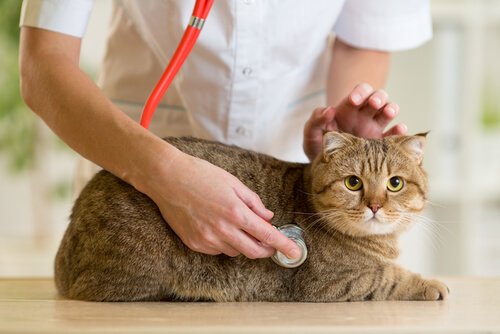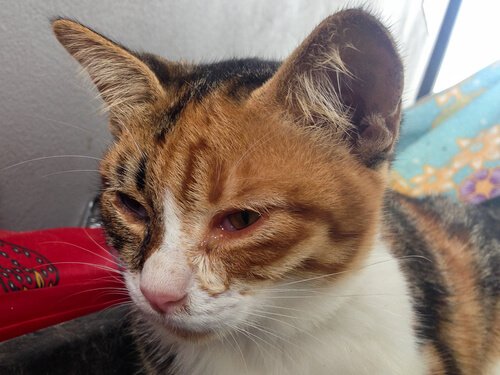Seven Common Diseases in Cats

As a cat owner, it’s your main responsibility to keep your pet healthy. And that’s something you shouldn’t take lightly. That’s why, if you’re a cat owner, it’s good to know what the most common illnesses in cats are, their symptoms, and how they’re treated. Continue reading this article to learn more.
What are the Most Common Illnesses in Cats?
If you’re thinking about adopting a cat, or if you already have one, then you should learn about the most common illnesses in cats.
1. Otitis
This inflammation of the ear canal is not just common in dogs but cats as well, especially adult cats. Otitis is very painful and it can cause loss of hearing if it isn’t treated on time.
It can be caused by several different types of mites, fungus, or bacteria, and the main symptoms are a yellowish or brown secretion from the ears, a bad smell, or desperate scratching at the ears.
2. Feline Leukemia
This is a type of cancer affects more cats than you might think, especially young and small cats. If it goes untreated, the consequences are fatal.

Among the main symptoms is a lack of appetite, anemia, drowsiness, general weakness, anorexia, or tumors.
3. Conjunctivitis (pink eye)
Though you might find it hard to believe, one of the most common illnesses in cats is the inflammation of the eye’s membrane. There are several causes…
Pink eye is caused by allergies, eye infections, environmental contamination, genetic problems, or injury.
You’ll easily notice if your cat has conjunctivitis. The eyes will be streaming out pus and they’ll have a darker cornea.

This can also cause sight problems. You may notice this if your cat starts bumping into things or doesn’t detect certain movements.
4. Feline Panleukopenia
Distemper is the virus that causes feline panleukopenia and it is similar to the disease that causes the parvovirus in dogs. It’s transmitted through having contact with the bodily fluids of an infected cat.
The symptoms of feline panleukopenia are a fever, vomiting, diarrhea, dehydration, and depression.
This disease can be prevented through vaccination and can be treated with antibiotics and an intravenous drip to re-hydrate the cat. If it goes untreated, then the consequence can be fatal.
5. Rabies
This is another common illnesses in cats which dogs have as well. This disease is transmitted by being bitten by an infected animal or coming into contact with their saliva.

The vaccine against feline and canine rabies is mandatory in many countries because it’s very contagious to to humans.
6. Feline Immunodeficiency
This is commonly known as “feline AIDS” because it’s very similar to HIV. Transmission often occurs during fights involving an infected animal. It can also happen during mating or be transmitted through the placenta of a pregnant cat.
One of the best ways to prevent immunodeficiency is to have your pet sterilized because there is currently no vaccine for this disease.

Furthermore, it’s difficult to detect symptoms until the condition is very advanced. This makes treatment very difficult.
7. Kidney Problems
Cats are highly prone to having cystitis, nephritis, and many other infections involving the urinary system. This is particularly true after a certain age. The build-up of minerals in the urinary tract — commonly known as stones — is very painful and will cause a change in their daily habits.
For example, a cat that has kidney problems may not urinate for many days, may continuously lick their genitals, and their urine — anywhere in the house or away from their litter box — will contain blood.
It’s absolutely important to immediately take your cat to the vet as soon as you notice any symptoms of a urinary infection. In most cases, this takes place when your cat has a change in his diet, such as salt-free foods, and medications that get rid of the mineral build-ups.
As a cat owner, it’s your main responsibility to keep your pet healthy. And that’s something you shouldn’t take lightly. That’s why, if you’re a cat owner, it’s good to know what the most common illnesses in cats are, their symptoms, and how they’re treated. Continue reading this article to learn more.
What are the Most Common Illnesses in Cats?
If you’re thinking about adopting a cat, or if you already have one, then you should learn about the most common illnesses in cats.
1. Otitis
This inflammation of the ear canal is not just common in dogs but cats as well, especially adult cats. Otitis is very painful and it can cause loss of hearing if it isn’t treated on time.
It can be caused by several different types of mites, fungus, or bacteria, and the main symptoms are a yellowish or brown secretion from the ears, a bad smell, or desperate scratching at the ears.
2. Feline Leukemia
This is a type of cancer affects more cats than you might think, especially young and small cats. If it goes untreated, the consequences are fatal.

Among the main symptoms is a lack of appetite, anemia, drowsiness, general weakness, anorexia, or tumors.
3. Conjunctivitis (pink eye)
Though you might find it hard to believe, one of the most common illnesses in cats is the inflammation of the eye’s membrane. There are several causes…
Pink eye is caused by allergies, eye infections, environmental contamination, genetic problems, or injury.
You’ll easily notice if your cat has conjunctivitis. The eyes will be streaming out pus and they’ll have a darker cornea.

This can also cause sight problems. You may notice this if your cat starts bumping into things or doesn’t detect certain movements.
4. Feline Panleukopenia
Distemper is the virus that causes feline panleukopenia and it is similar to the disease that causes the parvovirus in dogs. It’s transmitted through having contact with the bodily fluids of an infected cat.
The symptoms of feline panleukopenia are a fever, vomiting, diarrhea, dehydration, and depression.
This disease can be prevented through vaccination and can be treated with antibiotics and an intravenous drip to re-hydrate the cat. If it goes untreated, then the consequence can be fatal.
5. Rabies
This is another common illnesses in cats which dogs have as well. This disease is transmitted by being bitten by an infected animal or coming into contact with their saliva.

The vaccine against feline and canine rabies is mandatory in many countries because it’s very contagious to to humans.
6. Feline Immunodeficiency
This is commonly known as “feline AIDS” because it’s very similar to HIV. Transmission often occurs during fights involving an infected animal. It can also happen during mating or be transmitted through the placenta of a pregnant cat.
One of the best ways to prevent immunodeficiency is to have your pet sterilized because there is currently no vaccine for this disease.

Furthermore, it’s difficult to detect symptoms until the condition is very advanced. This makes treatment very difficult.
7. Kidney Problems
Cats are highly prone to having cystitis, nephritis, and many other infections involving the urinary system. This is particularly true after a certain age. The build-up of minerals in the urinary tract — commonly known as stones — is very painful and will cause a change in their daily habits.
For example, a cat that has kidney problems may not urinate for many days, may continuously lick their genitals, and their urine — anywhere in the house or away from their litter box — will contain blood.
It’s absolutely important to immediately take your cat to the vet as soon as you notice any symptoms of a urinary infection. In most cases, this takes place when your cat has a change in his diet, such as salt-free foods, and medications that get rid of the mineral build-ups.
This text is provided for informational purposes only and does not replace consultation with a professional. If in doubt, consult your specialist.








